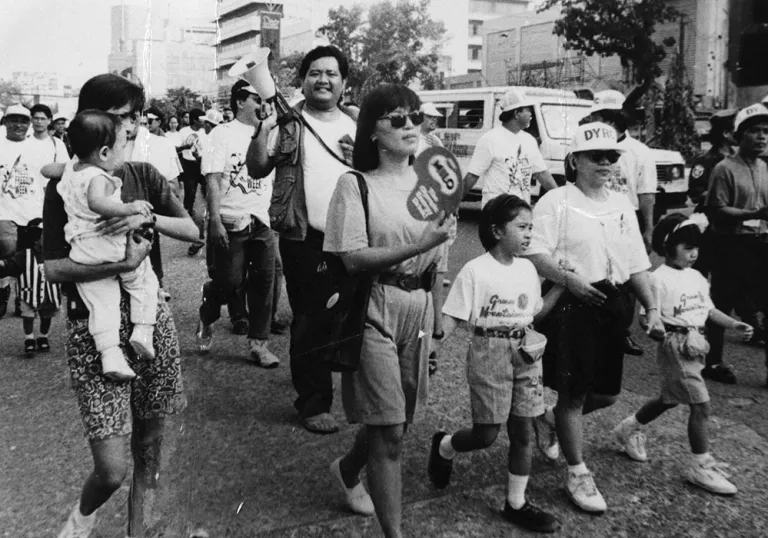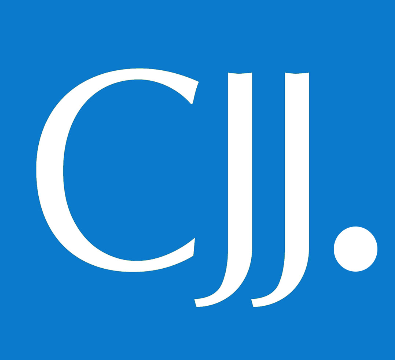A walk to remember: 17 years of Cebu Press Freedom Week
Cebu Press Freedom Week

The early years. From left, Mildred Galarpe, then from The Freeman; Jack Biantan (holding megaphone) and Thea Riñen (holding fan), both then from Sun.Star Daily (since renamed Sun.Star Cebu); and Jane Paredes (holding two children), then from dyRC, join the opening parade during an early celebration of Cebu Press Freedom Week.
A walk to remember: 17 years of Cebu Press Freedom Week
REBELANDER S. BASILAN
Sept. 22, 2011 ( CJJ6 )
It started as a simple activity in 1994. Looking back, journalist-lawyer Pachico Seares said the first Cebu Press Freedom Week (CPFW) featured a fun walk, an opening night and a closing night, with one or two forums in between.
The first CPFW, in which less than 50 people participated, was meant to show a unified media that responds to any attempt to suppress its rights.
“It has turned out to be more than that,” Seares said. “It’s a showcase of media unity but it’s also a reservoir of goodwill and fellowship, a place for colleagues and competitors to gather, talk, chill out.”
The beginning of CPFW can be traced back to as early as Sept. 10, 1988, when leaders of media organizations in Cebu formed the Council of Cebu Media Leaders (CCML).
Attacked
The early 1990s saw Cebu media attacked by outside forces. On Nov. 19, 1990, Bobby Nalzaro, then a commentator for radio dyMF, was mauled at gunpoint because of his report on the alleged excessive fare collection in barges plying the Mactan-Mandaue route.
On Nov. 5 1991, an official of the Narcotics Command (Narcom) 7 and three of his men barged into the Sun.Star Cebu newsroom and confronted columnist Wilfredo Veloso at gunpoint over his critical columns on Narcom’s anti-drug campaign.
These and other threats, including the attempt in 1992 to hold a congressional inquiry on alleged media corruption, prompted CCML to organize the first CPFW in 1994.
Unifying
Through the years, CPFW, or more strictly its concept of unity and working together despite the competition, has “spawned efforts and thrusts that collectively help make Cebu community journalists more blessed than their counterparts in the rest of the country,” Seares said.
It has led to the founding of institutions like the NewsCoop, Cebu Citizens-Press Council, Cebu Media Legal Aid and the Cebu Federation of Beat Journalists.
Then there are the structures and projects like the MBF Cebu Press Center, the Cebu Journalism & Journalists (CJJ) Gallery at Museo Sugbo, and the CJJ Magazine, now on its sixth edition.
“It has paved the way for the professionalization of the news media industry,” said Michelle So, Sun.Star Superbalita [Cebu] editor-in-chief and Sun.Star Cebu executive editor.
Jerry Tundag, editor-in-chief of The Freeman, said CPFW has proven to be a “unifying factor” for Cebu media.
“It’s a vehicle for bringing us together. We compete every day of the year. At least there’s one week we can come together and act as one,” he said.

From left, convenors Michelle So, Divine Ngujo, Carlo Dugaduga, Eileen Mangubat and Bobby Nalzaro lead a more recent Cebu Press Freedom Week opening parade.
Trouble
The holding of CPFW has not always been trouble-free, however.
Faced with criticisms about its legitimacy and motives, CCML cancelled plans to celebrate CPFW in 1996.
Some non-media groups took advantage of this move. Disguising as media practitioners, they solicited funds to be used purportedly for CPFW.
CPFW was revived the following year, this time by Cebu’s Working Media. The organizers limited the activities to actual members of newspapers and news and public-affairs broadcast stations. Members of dubious “media” groups were shut out.
In 1998, Cebu’s Working Media agreed to hold CPFW on the week that includes the 21st of September, to commemorate the declaration of Martial Law, which led to flagrant violations against press freedom.
The Cebu City Council and Cebu Provincial Board also passed resolutions declaring the week in September that includes the 21st as Cebu Press Freedom Week every year.
Money
There have been changes in the celebration of CPFW over the years.
“We used to have the Cebu City Government and the Provincial Government hosting lunches for the media. We’ve done away with these lunches because we didn’t want the celebration to have political color,” said So.
For many years now, only private businesses have been in the event’s sponsor list.
“From a shoestring budget, with only the organizers and friends of the press chipping in, its sponsors for the last seven years make an impressive list,” Seares said.
Organizers publish an accounting of donations and expenses to ensure transparency.
“No media celebration is as transparent as the Cebu Press Freedom Week,” said So.
Seares also noted that from less than 50 people on its first year, CPFW drew more than 500 participants in its 2010 opening activity.
“The improvements have been on color and liveliness, which in turn draw a bigger number of participants,” he said.
Other changes include the rotation of the job of convenor among Sun.Star Cebu, The Freeman and Cebu Daily News since 1999, and the adoption of a press freedom jingle in 2004.
This year, a board of trustees was activated when The Freeman begged off from the lead convenor job, Seares said. The board serves as convenor, with an executive committee headed by So as president and Seares as chairman of the board.

Opening and closing. Sun.Star Cebu employees present a production number during the opening day of the Cebu Press Freedom Week celebration in 2007. Right photo shows a group of mostly editors (from left) Nini Cabaero, Jane Paredes, Bobby Inoferio, Pachico Seares, Eileen Mangubat, Noel Pangilinan and Bobby Nalzaro presents a medley of songs during the closing day of an earlier Press Week celebration.
Activities were also refined into three major thrusts: Reaching Out to News Sources, Reaching out to Future Journalists, and Coping with New Media.
“We look forward to having more activities that will enhance the skills of journalists and give the public a better understanding and appreciation of what we do,” So said.
“CPFW is already a part of the Cebu press, an institution, an icon, often envied by other provinces, even by some sectors of the Manila media,” Seares said.
Caution
But he cautioned that the unity holding CPFW together can be fragile. The Cebu press community, he said, is also vulnerable to the common woes that afflict media practice everywhere.
“My hope is that the structures we all have helped build will hold, whatever ill wind might blow CPFW’s way,” Seares said.
For So, for as long as media workers in Cebu take their profession seriously, value press freedom, and keep the dynamism they have now, CPFW will be celebrated for many more years.
Quick facts
First press week. Council of Cebu Media Leaders (CCML) organized the first Cebu Press Freedom Week (CPFW) in 1994 (Sept. 18-24) “to remind the public that the precious freedoms it enjoys won’t be protected with the loss of press freedom.”
Always in September. It was only in 1995 and 1997 that CPFW was held in October (Oct. 22-28, 1995 and Oct. 5-11, 1997). Starting 1998 until this year, the 17th celebration, CPFW is celebrated on the week of each September that includes the 21st day, anniversary day of the declaration of martial law.
Legal mandate. CPFW is recognized by the Province of Cebu and Cebu City in separate resolutions declaring this particular week in September as Cebu Press Freedom Week yearly, with CPFW, Inc. as lead organizer and “franchise” holder.
Who runs the event? Cebu Press Freedom Week, Inc. runs CPFW with its board of convenors and an executive committee, with lead convenors (the three Cebu English papers), starting in 1999, taking turns. This year, instead of one of the English papers, a board of trustees was activated to serve as lead convenor.
What’s CPWF Inc.? Cebu Press Freedom Week, Inc. is a duly registered corporation officially representing both print media (five Cebu English dailies and two Bisaya dailies) and 18 (news and public affairs) broadcast stations.
Working press. Participation in the celebration is by membership of the individual in the staff of a newspaper or radio or TV station, not by fraternal organization. Thus, involvement of the actual working press, both print and broadcast, is assured.
Who participate? CPFW is mainly celebrated by:
(a) journalists accredited by their newspaper or (news and public affairs) broadcast station as members of the Cebu working press; and
(b) members of the support staff of a newspaper or (news and public affairs) broadcast station.
Not everyone gets in. There are CPFW activities that are:
(a) open to the public;
(b) open to specified guests such as mass communication students and faculty, news sources, or members; and
(c) strictly by invitation only (the host or sponsor selects the guests and issues the invitations). 
